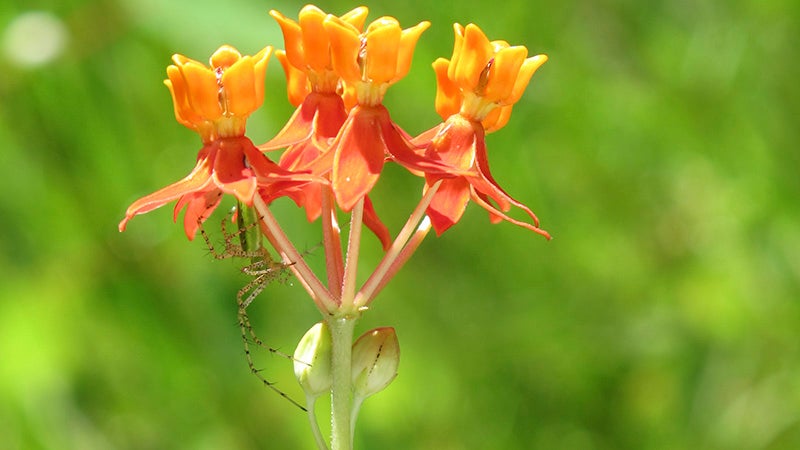Arboretum Paths: Peak season comes to the savanna
Published 7:00 am Wednesday, May 24, 2017

- HIDE AND SEEK: A green lynx spider hides beneath a cluster of fewflower milkweed blooms. Photo by Pat Drackett
By Pat Drackett, Director, The Crosby Arboretum
MSU Extension Service
Last week I took a cart ride through the Savanna Exhibit, soaking up the beauty of this twenty-acre exhibit from stem to stern with volunteer Jac Coleman, who was checking on his newly installed bee colonies.
The flowering perennials in the Arboretum’s savanna are currently experiencing one of their peak bloom periods. Recent columns have referred to the pink and yellow meadow beauties (Rhexia), flowering now.
It’s a delight to watch for orange fewflower milkweed as it continues to appear. You might pick out the flowers of this plant along the local roadside ditches from your car window. Both the bright orange-red blooms are distinctive, as are the tall seedpods that will follow the flowers.
Some years, in response to the particular combination of temperatures and rainfall, certain species are more prevalent in the savanna, and many of these are unquestionably stunning. This year we’ve noticed large areas of yellow-eyed grass (Xyris). Although the plant’s tiny flowers are held high on wispy stems, when growing in masses of several hundred blooms, in a grouping it makes quite an impression.
At certain times of the year, the combinations of plants blooming in the savanna will reach a crescendo, as the landscape transforms into a striking combination of pattern, color, and texture.
One of these events arrives in early spring, when the enormous blooms of yellow pitcher plants first emerge, and are suspended over an earthen floor composed of plant material still charred black from winter’s prescribed fire event and mixed with the bright green of new shoots of perennial grasses relishing the nutrients released by the recent fire.
Late fall brings several unforgettable perennial combinations. Shortly after the dramatic appearance of scarlet pine lilies that emerge unexpectedly and remain for only a day, a massive patch of purple Liatris begins to swell in the south pitcher plant bog. This serves as a magnet to area butterflies. Swallowtails, buckeyes, monarchs and other pollinating insects enjoy a nectar feast on blooms that intertwine with the hollow-stemmed pitcher plants that are turning from yellow to a range of rusts and reds. All of this is set in a matrix of white polka dot blooms called “bog buttons” or “ladies hatpins”.
After the show of Liatris, the savanna gives way to late-season swamp sunflowers (Helianthus) and asters, not long before the point it heaves a final sigh and enters into a short winter’s rest.
However, this currently splendid late May show is one that is not to be missed! So, if you have not been to the Arboretum in a while, we urge you to pay us a visit and take a stroll through the south pitcher plant bog.
While spring blooms tend to be more delicate in nature, they are brilliant in color. The bog is now a sea of bright yellow and vibrant pink, with dabs of orange fewflower milkweed and clusters of cottony gray golden crest (Lophiola aurea) providing accents to the symphony.
To Pearl River County residents, or Gulf Coast citizens in general, these landscapes may be every-day scenery to which we have become accustomed. But out-of-state Arboretum visitors often remark on the exotic destination that coastal Mississippi offers to them, especially those native plant fans who have chosen to visit because they are fascinated by carnivorous species, and who are thoroughly enjoying their experience.
Consider that at the time of European settlement, wet pine savannas and the longleaf pine ecosystem stretched from coastal Virginia across the Gulf Coast to eastern Texas, an area measuring approximately 90 million acres. The region contained around 1,200 different species of plants which occurred here and nowhere else. Today, only around three percent of this ecosystem remains, as human settlement has reduced this habitat to only isolated fragments.
Take a look at old photographs on the Internet of historical longleaf pine forests. Try to imagine what this coastal landscape looked like hundreds of years ago, when the pine forests stretched across our coastal south. Then, visit the Arboretum to learn about this landscape, and experience our twenty acre tract of this ecosystem that has been preserved, and is flourishing.
For more information, see www.crosbyarboretum.msstate.edu. The Arboretum is located in Picayune, I-59 Exit 4, at 370 Ridge Road (south of Walmart and adjacent to I-59).


